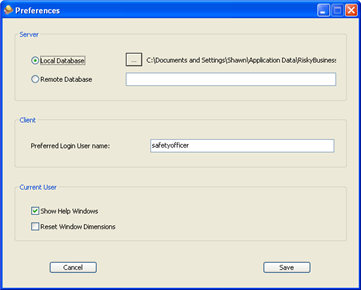Each installation of the Risky Business SOS software requires access to either a locally installed database file or one located on a network file server as well as a preference file. The default and demo installations of Risky Business SOS installs the database locally on your computer's hard drive. If you ever move the installation of the software to another machine or restore the data from a system backup, these two files must be copied or restored to the same location.
![[Caution]](images/caution.gif) | Caution |
|---|---|
If you install your database on a network file server, be sure that the computer running Risky Business SOS has read and write access to the network file server. If this is not the case you will not be able to access or change your data. |
This database contains all of the information that you see when running the program, including users, Standard Operating Processes, the Document Library and more. It is very important that this file be included with your company's daily backup of essential documents. If you do not have a daily backup procedure you may want to consider at least storing a copy of this file offline on a removable media like a writable CDROM.
To find the location of your database file, open the preferences window of the Risky Business SOS software. This option is available under the Edit menu at the top of the program. The location of the database is printed next to the words "Local Database".
For example, on a Windows computer it might be C:\Documents and Settings\bill\Aplication Data\RiskyBusinessSOS.sqlite. This means that the database is located on the C drive of your computer in the directory Documents and Settings\bill\Aplication Data\. The name of the database in this example is RiskyBusinessSOS.sqlite. You will find the preferences file in the same directory as the database. In this case it is RiskyBusinessSOSprefs.sqlite.
![[Note]](images/note.gif) | Note |
|---|---|
Your database is encrypted to protect its sensitive information. |
![[Tip]](images/tip.gif) | Tip |
|---|---|
If you expect to have multiple users logging into the same computer then you will need to move the database to a location accessible by each account (either on the same computer or on a network drive.) |
